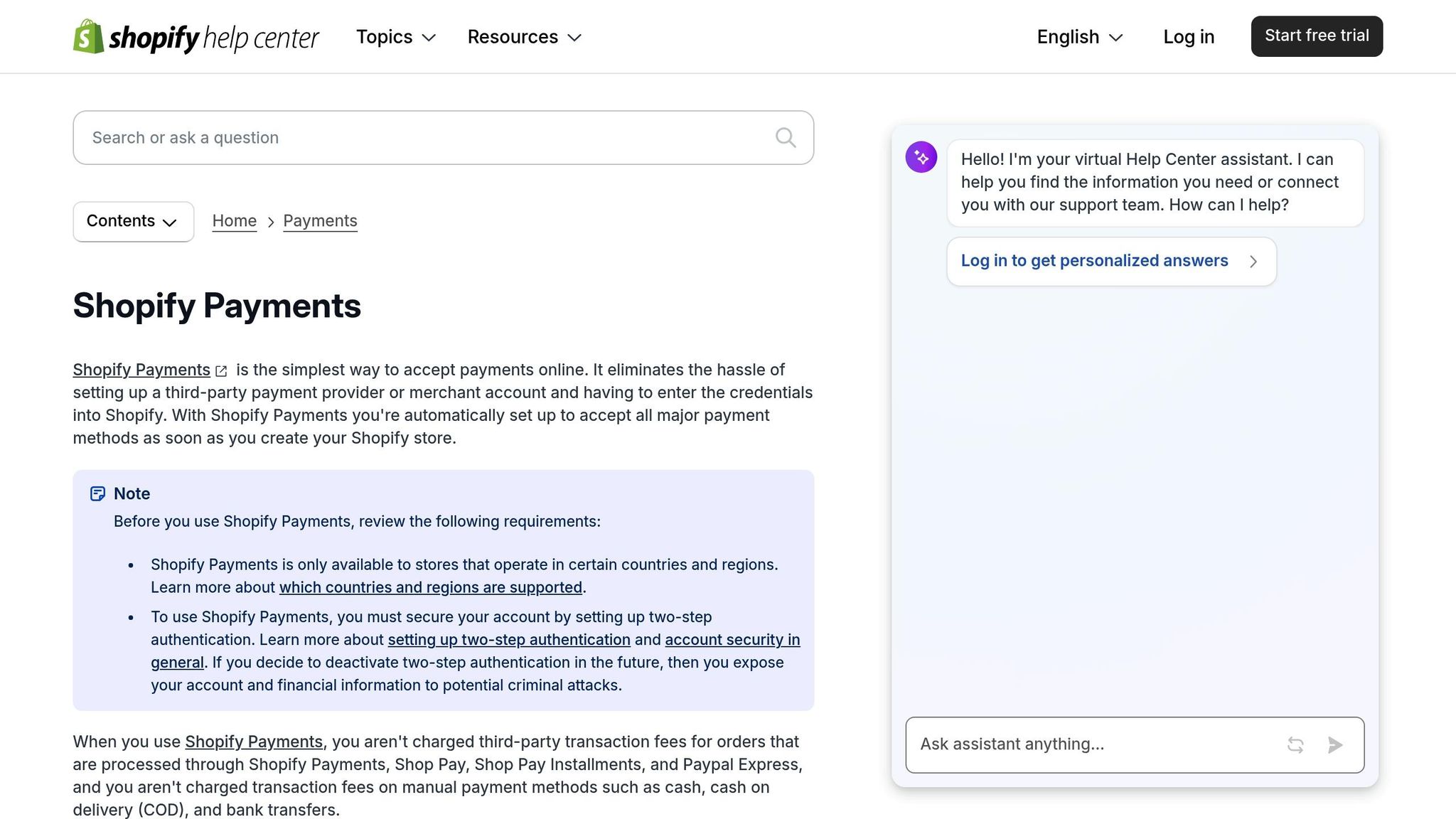Shopify is an easy-to-use platform that helps you create and manage an online store without needing technical skills. Here’s how it works:
- What It Does: Shopify provides tools to build a website, manage products, process payments, and track orders – all in one place.
- Why Choose It: It’s beginner-friendly, with features like drag-and-drop templates, 24/7 support, and plans starting as low as $5/month.
- Getting Started: Sign up for a free trial, pick a plan (starting at $39/month for basic features), and customize your store using free or premium themes.
- Adding Products: Upload product details, images, and pricing. Organize items into collections for better navigation.
- Payments & Shipping: Activate Shopify Payments to accept credit cards and set up shipping rates based on zones, weight, or flat fees.
- Managing Your Store: Use Shopify’s order processing tools, customer service features like live chat, and analytics to track performance.
Shopify is trusted by over 2.4 million merchants and makes starting an online business simple and efficient.
How to Use Shopify for Beginners – Crash Course Tutorial

Starting Your Store
Sign-Up Steps
Head over to Shopify’s website to sign up for their free trial – no upfront commitment required. You’ll need to provide some basic details about your business and selling goals. Once you’ve signed up, verify your account by clicking the confirmation link sent to your email. After verification, you can choose a plan that fits your needs, starting at $39/month for the basic tier and going up to $399/month for advanced features.
Store Design Basics
The appearance of your store plays a big role in attracting customers. Shopify sets a default theme when you log in for the first time. To personalize it, go to Online Store > Themes, select a free theme, and click "Customize." Here, you can adjust colors, fonts, and layouts to align with your brand, all through Shopify’s user-friendly theme editor – no coding needed. If you’re looking for more advanced design options, Shopify’s Theme Store offers premium themes with additional features.
Setting Up Your Web Address
A custom domain adds credibility to your brand. Shopify offers three ways to set up your store’s web address:
- Buy through Shopify: Shopify handles all the technical details, connecting your domain to your store instantly. You can manage everything from your Shopify admin panel.
- Connect an existing domain: Already have a domain? You can link it to your Shopify store while continuing to manage it with your current provider. Shopify allows you to connect up to 20 domains or subdomains.
- Transfer to Shopify: Move your domain management to Shopify for convenience. When you transfer, Shopify automatically creates an SSL certificate for added security.
Additionally, Shopify provides a free TLS certificate for your store, ensuring safe and secure browsing for your customers.
Adding Your Products
Product Information Setup
To add products in Shopify, head to the Products section in your admin panel and click "Add product." Here, you’ll enter all the details about your item.
Start with a title that includes important keywords to boost search visibility. Use the product description to highlight why customers should buy – focus on the benefits, not just the features. A recent study found that 87% of online shoppers are influenced by well-written descriptions when deciding to purchase.
Key details to include:
- High-quality images (with descriptive alt text for accessibility)
- Pricing information, including a "Compare At Price" if applicable
- Inventory details, such as stock levels
- Shipping specifics, including weight, dimensions, and origin
"A good Shopify product description can transform your sales, allowing you to reach new customers and convince uncertain buyers to purchase your offerings." – Alexandra Zolotorevich, Product Marketing Manager at Amasty
Once your products are added, organize them into collections to make browsing easier for your customers.
Creating Product Groups
Using collections in Shopify helps customers find what they need faster. Shopify offers Manual Collections and Automated Collections to help you structure your store.
- Manual Collections: These let you handpick products for specific groups, such as seasonal items or limited-time promotions. You control exactly what goes into each collection.
- Automated Collections: These save time by automatically grouping products based on conditions you set, like tags or inventory status.
To create collections:
- Go to Products > Collections in your admin panel.
- Choose a descriptive title that will act as the collection’s main heading.
- Add a description optimized for search engines to improve visibility.
- Set up conditions for automated collections or manually select products.
- Use tags and categories to further organize your inventory.
Keep in mind that Shopify displays up to 50 products per collection page. To improve navigation, start with broader categories like "Men’s Clothing" and break them down into subcategories like "Men’s T-Shirts." This structure helps customers find what they need quickly and efficiently.
sbb-itb-6768865
Payment and Shipping Setup
Shopify Payments Setup

To start accepting orders, activate Shopify Payments. Here’s how you can set it up:
- Go to Payments in your Shopify admin.
- Click "Complete account setup."
- Provide your business and banking details.
- Enable two-step authentication.
Once activated, you can start accepting major credit and debit cards with CVV verification right away. Keep in mind that setup requirements may vary depending on your location, so have your tax documents and bank information ready.
Additional Payment Options
Offering more payment options can help lower cart abandonment and increase sales. In the Payment providers section of your Shopify admin, you can enable popular methods like:
- PayPal
- Amazon Pay
- Apple Pay
If you sell subscription-based products, Shopify Payments is recommended as your main gateway. After setting up payments, the next step is configuring your shipping settings.
Shipping Rules and Costs
-
Define Shipping Zones
Decide which regions you’ll ship to and create shipping zones in your Shopify admin. -
Set Up a Rate Structure
Create a shipping rate system that aligns with your business goals. Here are some common approaches:Rate Type Ideal For Customer Experience Flat Rate Simple operations Predictable costs Weight-Based Bulkier items Fair pricing Free Shipping Threshold Boosting order value Encourages larger purchases -
Configure Carrier Services
Use your Shopify admin to connect with carriers and calculate real-time shipping rates.
Store Management Basics
Order Handling
Managing orders efficiently is crucial for running a successful store. The Orders page in your Shopify admin acts as the main hub for processing purchases. When an order comes in, you can choose between two fulfillment methods:
| Fulfillment Type | Best For | Key Features |
|---|---|---|
| Manual Fulfillment | Physical products, custom items | Gives you full control over shipping and personalizes the process. |
| Automatic Fulfillment | Digital downloads, dropshipping | Operates hands-free with instant processing. |
For manual fulfillment, Shopify Shipping can simplify your workflow. This tool allows you to purchase and print shipping labels directly from your admin panel. You can also enable automatic archiving for completed orders.
Customer Service Tools
Order processing is just one part of the equation – providing fast and effective customer support is just as important. Shopify Inbox, a free messaging tool, can help you stay on top of customer inquiries. With this app, you can:
- Chat with customers in real time from your desktop or mobile device.
- Assign specific conversations to team members for better organization.
- Create pre-filled orders during live customer interactions.
In addition, establish clear policies, offer multiple ways for customers to contact you, build a helpful FAQ, and set up automated email notifications to keep communication smooth.
Store Performance Tracking
Keep an eye on your store’s performance using Shopify Analytics. This tool offers powerful tracking features to help you understand how your business is doing. The Live View feature provides real-time updates on:
- Current visitor activity
- Transactions in progress
- Checkout steps being completed
- Sources of incoming traffic
You can also use cohort analysis to identify customer retention trends and key segments. Shopify Analytics comes with pre-set date ranges, making it easy to compare performance during major shopping events like Black Friday Cyber Monday.
Here are some key metrics to track every day:
| Metric | Why It Matters |
|---|---|
| Conversion Rate | Reflects how effective your store is at turning visitors into buyers. |
| Average Order Value | Shows the typical amount customers spend per transaction. |
| Customer Return Rate | Indicates how often customers come back to shop again, a sign of loyalty. |
Next Steps
Setup Checklist
Before you launch your store, double-check these key areas to ensure everything runs smoothly for your customers:
| Setup Area | Key Items to Check |
|---|---|
| Website Pages | Homepage, About, Contact, FAQ, Shipping/Returns Policy |
| Technical Elements | Mobile responsiveness, site speed, working links |
| Customer Service | Contact options, automated emails, order tracking |
| Payment & Shipping | Multiple payment methods, accurate shipping rates |
| Legal Requirements | Privacy policy, terms of service, tax settings |
Make sure your content is free of spelling and grammar errors, links work properly, and your site is mobile-friendly.
Quick Start Guide
Once your store’s technical and operational aspects are squared away, focus on these steps to start growing your business:
-
Define Your Target Market
Create detailed buyer personas to help tailor your product descriptions, website design, and marketing efforts to your audience’s needs. -
Establish Your Brand Identity
Stick to a straightforward color palette, use no more than two fonts, maintain a clear brand voice, and invest in a professional logo. -
Optimize Your Store Setup
Use a custom domain for a polished look, craft privacy policies specific to your business, install only the apps you truly need, and set up email marketing flows to engage your customers.


